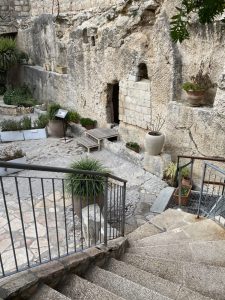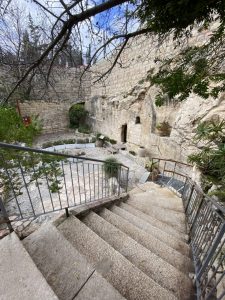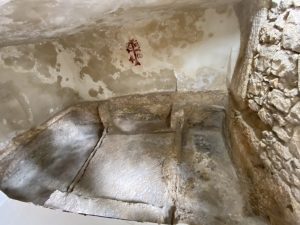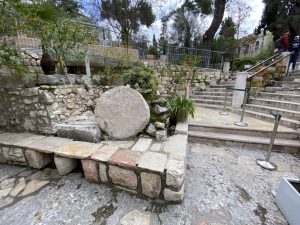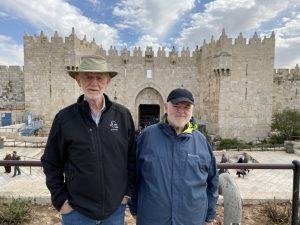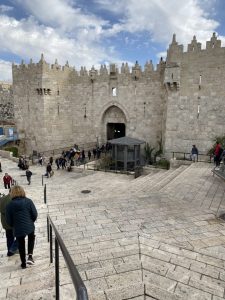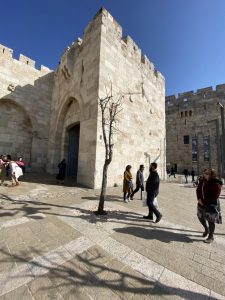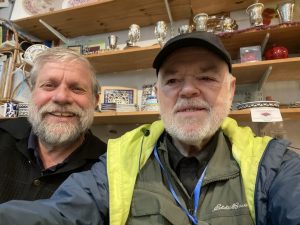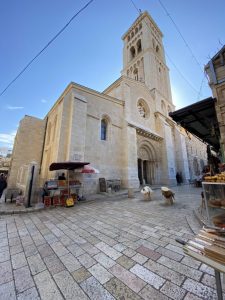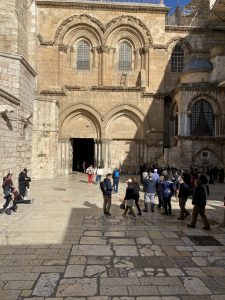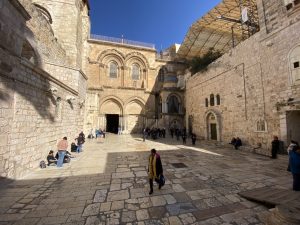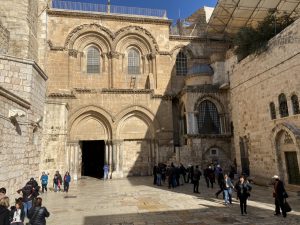ISRAEL PILGRIMAGE – WINTER 2020
Thursday-Jan 9, 2020
P/U group airport-We were there about 1 1/2 hours. They have an Aroma Espresso Bar right at the entrance/exit for group pickup. The group had a bit of a problem getting thru immigration but they all got through and got their luggage.
They were tired. We had a full day ahead of us but it was raining, really raining outside.
Israel is experiencing the heaviest rain in 50 years in the north and the heaviest rain in 79 years in the south. The worst flooding was in the south because the land is dry, desert while the north is relatively green. We didn’t have any problem from flooding at the airport or where we were going but it was raining heavily.
We had lunch at Or Akiva. This is a local mall near Caesarea. It’s a good chance for the folks to mix with locals and hear the Hebrew language being spoken. Many of the folks had McDonald’s, or pizza or other types of sandwiches. We ate at the Aroma Espresso and had salads, sandwiches or soup. Still raining.
We got to Caesarea about 1pm and the rain stopped. We walked thru the amphitheater, had a devotional, went to Herod’s Palace and then returned to the bus. Very little rain until we got back on the bus and left Caesarea
Mt Carmel was a 45 minute drive in the rain. Their guard saw us coming up the road in the heavy rain and opened the gate so that we could drive up near their chapel. We got off the bus in a pretty good rain and went into the chapel. Outside was the statute of Elijah slaying the prophets of Baal. Excellent devotional in the chapel. Some of the folks went up-stairs to the roof to see the view of the beginning of the Jezreel and across the Lower Galilee. There is a list of things one can see but it was raining and folks didn’t take much time looking around. This was a bathroom stop also and then all of us got on the bus. The rain had begun again fairly hard, it was cold, everyone arriving had been awake a long time so we bypassed Nazareth and went straight to Nof Ginosar where we would overnight for 4 nights.
My first experience at Nof Ginosar was in 1992. We stayed at an inexpensive place nearby that didn’t serve food so I went by and met their Food service manager and we began a friendship that’s lasted until today. I contracted with him for our breakfast and dinner for about 10 years when we were in the Galilee unless we were staying at a place that had food service. The food at Nof Ginosar has always been the very best food in the Galilee. Based on our meals so far this week it still is excellent.
At 5:20 pm we had Bible Study in the Mt. Hermon room. Dr Dukes is leading us through the General Epistle of James.
Dinner
Heavy rain all evening.
FRIDAY -JAN 10
We got up this morning and the sky was cloudy but not raining. We had breakfast and loaded the bus for the morning devotional by Dr. Parker-He is talking about faith in Hebrews.
We walked across the parking lot to the Ancient Boat exhibit and then left the pavilion and walked down to the dock to get on the Galilee Boat. We cruised the northern part of the Sea of Galilee pointing out the various landmarks for our folks. Most of the people are first timers in Israel. That is a rewarding experience to be with folks on their first trip to Israel. We had our devotional on the boat and sailed back to Nof Ginosar with the sun peeking through the clouds. We left the boat and loaded the bus and headed out to visit the Mount of Beatitudes.
It is a beautiful day. A little chilly, a little cloudy but amazingly some sun peeking out. By the time we got to the Mount of Beatitudes there was no threat of rain. We had a great time visiting the site, having our devotional, taking pictures and then we returned to our Bus. Our driver is Dobi. He’s driven for us a lot and we really like him. He is very good at driving. Very good.
We went down through the natural amphitheater of the hill and drove around to the Primacy of Peter where Jesus met the disciples as they were coming in from fishing all night. He suggested the throw their nets again and they caught so many fish that the net barely held them and Peter realized it was the resurrected Lord Jesus. Beautiful chapel on this site and I really always enjoy visiting here because of the simplicity of the site. We always take pictures.
Capernaum was just up the road from the Primacy and that was our next stop. We visited the town of Jesus and the synagogue of Jesus. Pictures, our devotional on the site, commentary about the site including Peter’s house and then returned to the bus where we would load up and go to dinner in Migdala.
We had lunch at a Falafel stand in Migdala that also serves schnitzel and shawarma. Lunch didn’t take long and we were on our way in beautiful weather. Thank you Lord. It was still raining in many places in Israel.
Kursi on the eastern shore of the Sea of Galilee was our next stop. Kursi is the site of the largest known Byzantine monastery complex in Israel, whose impressive remains have been partly reconstructed. On the side of the hill behind the monastery are the remains of an earlier chapel, built into a cave.
This is the traditional site for the healing of the demoniac of Gergasa and the casting of the demons into the swine. Excellent site that gives a good representation of a basilica.
We left Kursi and drove further down the eastern shore toward the turnoff to Hippos, one of the towns of the Decapolis-a Roman city during the time of Jesus. Oops we got there and the road was cut so we wandered in the bus through a farm-banana farm trying to get around the cut. We couldn’t. Bummer. On the way out of the banana farm we stopped a four-wheeler and asked why the road was cut? He said in the heavy rains, some land mines were washed out of the ground and were on the roadway up the mountain. Thank you Lord the road was cut and we couldn’t drive up the mountain.
Today at sundown Shabbat begins, shalom Shabbat! We had about an hour or so before everything closed so we visited Aroma and had coffee-I had ginger and turmeric tea, and then drove around the southern end of the Sea of Galilee to Tamar Bakfar-dried fruits, nuts, teas and an excellent stop.
Back to Nof Ginosar for overnight. Bible study in James. Off to be and 6am came way before I was ready!a
Thank you for praying for us. Many blessings.
SATURDAY – JAN 11
Beautiful weather again where we are and heavy rain continues north of and south of us.
Breakfast at Nof Ginosar is outstanding. We don’t have hot food this morning because it was Shabbat. But there were eight kinds of bread, a multiplicity of pastries, five homemade jellies and jams, fresh vegetables, multiple salads and juices and coffee. I think breakfast in Israel is my favorite meal.
Our first stop is BEIT SHEAN a city in the Northern District of Israel, which has played an important role in history due to its geographical location at the junction of the Jordan River Valley and the Jezreel Valley. In the Biblical account of the battle of the Israelites against the Philistines on Mount Gilboa, the bodies of King Saul and three of his sons were hung on the walls of Beit She’an (1 Samuel 31:10-12). In Roman times, Beit Shean was the leading city of the Decapolis, a league of pagan cities. Beit Shean was occupied as early as 6,000 BC and with a few periods of non-occupation continues to be a city until this day. It has a long period of control by the various civilizations that ruled in the various periods. But we are focusing primarily on the Biblical account in the Old Testament and the Roman occupation during the New Testament times. It was and is an important city. In Biblical times it was most often a pagan city.
We were at Beit Shean about 2 hours and then drove to BETH ALPHA. The Beth Alpha synagogue was uncovered in 1928 by members of the nearby Kibbutz Hefzibah. They stumbled upon the synagogues extensive mosaic floors during irrigation construction. Excavations began in 1929 under the auspices of the Hebrew University of Jerusalem and were led by Israeli archaeologist, Eleazar Sukenik. In 1962 Israel Antiquities Authority explored the residential structures surrounding the synagogue. We don’t really know why they had zodiac representations and other pagan symbols in their mosaics. It could have been for a variety of reasons, including the possibility of syncretism.
Our next site was EIN HAROD On the slopes of Mount Gilboa. It has a cold spring that bubbles in a cave that flows into the Jezreel Valley. Although a peaceful setting today with green lawns and eucalyptus trees for shady picnics, it was at one time known only for war. More than 3,000 years ago, after Joshua’s victories and before the time of the Kings, 15 different Judges ruled Israel. These Judges, 14 men and one woman, were more like “deliverers” than what we think of as actual judges today. One of the most famous of these Judges was the “warrior” Gideon. He may not have seemed like a warrior when the angel found him threshing wheat in a winepress (Judges 6:11), and making excuses (Judges 6:13-17), but he did eventually live up to the angel’s greeting. This “mighty warrior” delivered Israel in spectacular fashion. The “Spring of Harod” is the pool where Gideon chose his 300 warriors to battle the Midianites. The warriors were chosen based on how they drank water (Judges 7:1-8). Those who lapped the water like dogs were left behind in historical obscurity. The 300 warriors who drank with a cupped hand went on to immortality. God ordered Gideon to send away 22,000 troops, confusing the Midianites. This spring holds the history of the beginning of a great battle. What started as a battle with tens of thousands became a battle of mere hundreds. The water test dropped Gideon’s army again to a mere 300 men! Who would dare lead such a tiny army against 135,000 Midianites? Maybe the One who holds all things in His hands. In Judges 7:2, God explains that He is the source of our power over impossible circumstances. In Gideon’s case it was God-sized odds, 450 to 1. This lesson still rings true for all of us today; faith in the one true God of Israel is a majority no matter what the odds. The Lord said to Gideon, “You have too many men. I cannot deliver Midian into their hands, or Israel would boast against me, ‘My own strength has saved me.’ (Judges 7:2)
We left Ein Harod and went to Tel Megiddo-(Armageddon). We had lunch first and then toured the site. This is the site of the ancient city of Megiddo. (A Tel is an archaeological mound.) It is situated about 30 km south-east of Haifa. Megiddo is known for its historical, geographical, and theological importance, especially under its Greek name Armageddon. During the Bronze Age, Megiddo was an important Canaanite city and during the Iron Age, a royal city in the Kingdom of Israel. Megiddo drew much of its importance from its strategic location at the northern end of the Wadi Ara defile, which acts as a pass through the Carmel Ridge, and from its position overlooking the rich Jezreel Valley from the west. Excavations have unearthed 26 layers of ruins, indicating a long period of settlement.
Time seems to pass too quickly on these pilgrimages. We hurry across lower Galilee to Sepphoris or Zippori. It is a village and an archaeological site located in the central Galilee region of Israel, 6 kilometers north-northwest of Nazareth. It lies 286 meters above sea level and overlooks the Beit Netofa Valley. The site holds a rich and diverse historical and architectural legacy that includes Hellenistic, Jewish, Roman, Byzantine, Islamic, Crusader, Arab and Ottoman influences. In early Christian tradition it was believed to be the birthplace of Mary, mother of Jesus. Today a 5th-century basilica is excavated at the site honouring the birth of Mary. Notable structures at the site include a Rloman theatre, two early Christian churches, a Crusader fort partly rebuilt, and over sixty different mosaics dating from the third to the sixth century AD. We walked most of the site and it has a steep hill where the Crusader fort and a Roman residential structure is and then down the hill to walk the ancient streets of the Roman town of Sepphoris.
We completed our tour of Sepphoris at 4 pm. It gets dark today at 5:15pm so we hurried across the Lower Galilee to the Porian descent down Highway 768 from sea level to 700 feet below sea level to Highway 90 so that we could see from sea level the beautiful view of the southern end of the Sea of Galilee. (PORIYA comprises three adjacent villages south of Tiberias in northern Israel, specifically Poria, Poria Illit, and Poria-Kfar Avoda. All three lie along Route 768 overlooking the Sea of Galilee. As of 2006 the cumulative population was 1875.)
We drove north on Highway 90 through Tiberias and Magdala to our hotel Nof Ginosar for our Bible Study at 5:45pm and dinner at 6:45pm.
It was a really good day. Our group is outstanding. Everyone has done their best to keep the group moving efficiently so that we can see everything we can of the land of Israel. This is shaping up to be the very best tour EVER!
Thank you
Clay
SUNDAY – JAN 12
We left Nof Ginosar at 8am. Dr. Parker continued our morning devotional in Hebrews.
Chorazin was our first stop today. It is located above the Sea of Galilee about 300 feet above the Sea of Galilee and is on Hwy. 8277 about a mile from Vared HaGalil. Chorazin along with Bethsaida and Capernaum, was named in the gospels of Matthew and Luke as “cities” in which Jesus performed mighty works. However, because these towns rejected his work (“they had not changed their ways”), they were subsequently cursed (Matthew 11:20-24; Luke 10:13-25). The gospels make no other mention of Chorazin or what works had occurred there.
Their currently is more archaeological work on the site.
They have a synagogue from the 4th Century that was destroyed and rebuilt in the 6th Century. It is a black basalt synagogue, similar to the original synagogue at Capernaum. We had our site devotional and took a group picture. Walking into and out of the site was easy now since they have put in a concrete walkway for easy access. We are facing a real time crunch today so we were not here long. Folks took pictures and asked questions and we loaded the bus and headed north up highway 90 passing Tel Hazor, the chief of the three (Tel Gezer, Tel Megiddo) treasure cities.
Tel Dan (ancient Laish) is located due north up the Hula Valley on Hwy. 98 in Israel on the Lebanon border. It is one of the important antiquities sites in Israel, and the state of Israel has proposed that it should be declared a World Heritage Site. The city of Dan is mentioned in a number of sources – in Bible stories and in archaeological finds from Egypt and Iraq. The ancient city reached its height during the Canaanite and Israelite periods. In the days of the Kingdom of Israel, King Jeroboam set up one of the golden calves at Dan. The excavations at Tel Dan have been ongoing for decades, and have revealed, among other things, a Canaanite brick gate that is considered to be the earliest of its kind in the world, and fragments of inscriptions mentioning the House of David and the name of the ancient city.
We were permitted to enter at the back gate. The rain has flooded much of the site and we were not interested in slogging through the mud on the main trails of the large Tel. By entering the back Gate we were able to visit the Abraham Gate and the Israelite (Ahab) Gate.
Abraham Gate (the Canaanite Gate) – an ancient gate from the Canaanite period. The gate was made of mud bricks, and has been preserved to its full height of 7 m. We walked back toward the exit gate and visited the Israelite (Ahab) Gate. Good site visit and out the exit gate and we were on our way around to Caesarea Philippi about 3 miles around from Tel Dan on Hwy. 98.
Caesarea Philippi (Banias) was a place of Pagan Worship from the earliest times. The landscape has an abundance of water. This forms a series of water catchment areas within the Banias National Park, one of the distributary channels of the Jordan River, and a 10-meter waterfall, the largest in Israel.
Alexander the Great conquered this region and from here started his Hellenization of Egypt and Syria. The numerous natural resources have made Banias a place of pagan worship, especially of the god “Pan”, from which derives the name of the place: “Panias”, in Arabic “Banias”, since in the Arabic language there is no letter “P “.
“In the Hellenistic era, the city experienced moments of prestige. Here Herod built a temple in honor of Emperor Caesar Augustus and, before dying, divided his kingdom among his three sons. Banias was destined for Philip, who made it the capital of his kingdom by giving it the name “Caesarea di Philippi” to distinguish it from Caesarea Marittima, on the coast of the Mediterranean Sea. During his reign, the region developed economically and culturally: coins were minted, and temples, baths, theaters and other public buildings were built.
The archaeological site is located at the foot of Mount Hermon, on the Golan Heights, near the border with Syria and Lebanon. Those visiting it can see the ruins of different eras, ancient structures, palaces, an old water mill in operation, the Grotto of Pan and even touch the refreshing waters of the Hermon River. But above all, the place marks the moment when the identity of Christ and the mission of Peter were understood.
Jesus visited the location cited as the “Gates of Hell” where Christ taught his disciples, Matthew 16:13-19, and had his interchange with Peter.
After Peter confessed Jesus to be “the Christ, the Son of the Living God”, Jesus replied , “On this rock I will build my church and the gates of Hades shall not prevail against it. And I will give you the keys of the kingdom of heaven, and whatever you bind on earth will be bound in heaven and whatever you loose on earth will be loosed in heaven” (Matthew 16:18, 19). This discourse continued and our site devotional dealt with this statement of Jesus to His disciples.
We had lunch in a Druze village, Masade, at a local cafeteria offering a Druze specialty sandwich of unleavened bread, labneh cheese and hyssop, falafal pita which is excellent or chicken schnitzel in a pita. Lunch was at 3,200 feet above sea level which means we have climbed from 700 feet below sea level to 3,200 feet above sea level here on the side of Mt. Hermon.
We met Ilan Shulman at Merom Golan about 1:30pm for our Jeep Adventure in the 4,000 acres of Kibbutz Merom Golan. Ilan is an IDF Intelligence Officer in the Region and after we four-wheeled up to the Syrian-Israel border he shared with us the terrorist situation on the border and in their area of the Middle East. We finished our time with Ilan’s group about 4pm and drove back to Nof Ginosar. It was foggy coming down the Golan. We arrived back at our hotel about 5pm.
Bible Study at 5:45pm, dinner at 7pm and then off to bed (in a few minutes).
MONDAY – JAN 13, 2020
The trip down the Jordan Valley to Bethabara, the ford in the Jordan where John was Baptizing took about 1 1/2 hours. The Jordan is full, and the land is lush and green. They have just had one of the heaviest rains in 50 years here in the Jordan Valley and indeed rain records have been recorded all over Israel with heavy flooding in many of the desert areas. The wadis going to the Dead Sea have been glutted with water but I don’t think they have had any drownings down there.
Bethabara. “house of the Ford, place of crossing”) name used by some versions of the New Testament for the site “beyond Jordan” where John the Baptist was Baptizing. This is traditionally where he baptized Jesus. “Bethabara” also appears on the 6th-century Madaba Map.
Traditions based on interpretations of the scriptural texts connect the site with two other miracles: the crossing of the River Jordan, whose waters were divinely restrained and Joshua led the twelve tribes of Israel into the Promised Land and the place where the Prophet Elijah was taken to heaven in chariot of fire (2 Kings 2:9, 11). When we arrived we were going to walk down to the water but we discovered the water had come up to us as the Jordan had seriously risen and was almost up to our landing. It would be very hard to baptize someone in the Jordan today.
We continue down Hwy. 90 toward Qumran which would be our next stop. We pointed out Jericho, the Judean Wilderness where Jesus fasted for 40 days and Kalia Beach where we would finish our day floating in the Dead Sea.
QUMRAN and the discovery of the Dead Sea Scrolls is probably the greatest archaeological find in history. In one event we moved the Oldest Old Testament translation back in time from 1,000 AD to 200 BC. Now we had OT Bible in Hebrew that dated 1,200 years older and they were exactly without any major differences like those current translations of the OT Bible. Dr. Parker took us through the details and then we toured the site. Qumran is amazing. We had lunch and then hit the road for Masada, the wilderness fortress.
MASADA – The fortress of Masada was built in the year 30 BCE by King Herod, whose architectural feats have left their mark throughout the country. At the beginning of the great revolt against Rome in the year 68 CE, the site was conquered by a group of Jewish zealots, and Masada became their last stronghold.
In the year 72, the Romans besieged Masada and succeeded in reaching the steep fortress after constructing a huge earthen ramp on its western side. In the year 73, the 960 Jewish zealots living at the top of Masada chose to commit suicide rather than to fall into the hands of the Romans alive. Their deeds left behind a saga of courage, heroism, and martyrdom.
We took the lift to the top of Masada and toured the site. It’s huge and we spent about 2 hours in the fortress.
KALIA BEACH-I think about 15 folks went into the Dead Sea to float in that extremely salty, mineral water. It’s different. The stuff in the water is great for psoriasis, other kinds of sores, and general aches and pains. The black mud on the bottom is prized for its healing properties. There is much more to it but that generally summarizes the facts. It is important and its good for folks to experience it.
It was dark as we entered Jerusalem. The 15 miles from Kalia Beach to Jerusalem goes from 1,300 feet below sea level to about 2,900 feet above sea level. A 4,200 foot climb in 15 miles which is a fair climb. My ears popped about 1,000 feet above sea level.
The Dan Panorama would be our home until we depart late Thursday night. Our fair-well dinner will be here at the Dan right before we go to the airport to return home.
We had dinner at 6:30 and Bible Study at 7:30pm.
Our tour has been extremely exciting and our students intently involved in the examining the land of Israel. It is really wonderful to travel with so many first timers to the Land of the Bible. The pilgrimage is everything we planned for it to be. If you have not been to Israel, you really need to come.
One of the students when we were at Gethsemane asked if this was part of the Mount of Olives. Yes it is and in fact it is at the base of the Mount of Olives. “You mean it’s that close?” Yes it is. Then I showed him how when Jesus came to Jerusalem he would go thru Bethany about 1 1/2 miles from Jerusalem on the south-eastern slope of the Mount of Olives. Then he would continue to the top of the Mount of Olives which was a sabbath day’s journey from Jerusalem (2/3 of a mile). The brow of the Mount of Olives is where we would have a beautiful view of the Jerusalem ( also where on Palm Sunday they hailed Jesus as the king and he said if he hushed the crowd the rocks would cry out). Down at the bottom of the hill is Gethsemane which means “olive oil press” and indeed is an Olive tree orchard with some of the trees more than 2,000 years old. Great question as were hundreds of other questions.
Another good day and an excellent pilgrimage continues.
TUESDAY – JAN 14, 2020
WE DONT REMEMBER DAYS. WE REMEMBER MOMENTS
We are at the Dan Panorama until the group leaves Thursday night after our farewell dinner. The week will go fast. Breakfast then we leave the hotel for our touring day.
Gethsemane is our first stop. We are the early birds here because everyone else is on the Mount of Olives. There are only a few groups here and the Catholics priest, Spanish, permits us to go into the Garden even though our appointment is at 10am. Blanca asks him for permission in Spanish and I think received favor because she spoke to him in their native language. Chilly. Devotional overlooks the Kidron Valley and looks up at the Eastern Gate (Golden Gate). The Garden has some olive trees that date back to the time of Christ (the roots do anyway because the Romans in 70AD destroyed everything in Jerusalem-the roots would have survived).
Mt of Olives is our second stop. It’s bit of a drive to get around by Wadi Joz and then up the hill. The traffic is ferocious as it often is in Jerusalem. The view of the Old City is spectacular and the students had a lot of fun riding the camel. Our devotional was in a small alcove overlooking the Kidron Valley and the Old City of Jerusalem. It is crowded but some of the 8 o’clock crowds have departed. Dobi winds up directing traffic to get everyone in and out.
The Old City of Jerusalem is circled by a wall almost 1 1/2 miles in circumference. Starting with the Jaffa Gate on the West side of the city. You enter the Christian Quarter or Armenian Quarter through this gate and traveling clockwise around the city the next gate is the New Gate, maybe two hundred plus years old that was cut so the Catholics could get to the Latin Patriarchate without going through the Moslem Quarter. The Damascus Gate is next and is on the north side of the Old City and is the border for the Moslem Quarter. The Herod Gate (Flower Gate) is next about 200 yards further from the Damascus Gate and enters into the heart of the Moslem Quarter. Continuing our trip around the Old City the Lion Gate (St. Stephen’s Gate) is next and it also enters the Moslem Quarter and the beginning of the Via Dolorosa. The Dung Gate (and next to it a very small gate called the Tanner’s Gate) is next and it is on the southern side of the Old City and enters the Jewish Quarter. Next is the Zion Gate. It enters the Armenian Quarter and the western side of the Jewish Quarter. That completes our circuit of the Old City and its gates.
St Peter in Gallicantu (the place of the cock crowing) is our next stop. This is the traditional location of Caiaphas’ House where Peter denied Jesus. There is a Roman Stepped Way next to this location. This Stepped Way dates back to the time of Jesus and would have been the way that the guards/soldiers would have brought Jesus from the Garden of Gethsemane across the Kidron Valley and up to Ciaiphas’ House.
We left St. Peter in Gallicantu and drove down to Ramat Rachel for lunch. This is a very wealthy kibbutz on the outskirts of the city and borders Bethlehem.
Church of the Nativity in Bethlehem was our next stop. We crossed the border into the Palestinian Terr. and traveled Manger road to Manger Square and the Church of the Nativity. Adjoining the older facility is a fairly new St. Catherine’s Roman Catholic Church. The visit went well, we were only in line about 30 minutes because we came before 1pm while others are having lunch.
Edward Tabash and sons people meet us at the border and run interference for us the whole time we are in the Palestinian Territory. The group visited their Olive Wood store after our visit to the Church of the Nativity.
Returning to Israel from Bethlehem we visited the American Embassy right on the border and then the very large scale model of Jerusalem at the time of Christ and the Shrine of the book where the Dead Sea Scrolls are stored.
Devotion in the Alon Room at the Dan Panorama, dinner and the day was over for me. I was worn out. It was a rewarding, long day.
Blanca and Jim Parker took those that wanted to over to Shaban’s store in the Christian Quarter for shopping. It’s magical, exciting, memorable to walk through the Suk at night. They had a good time.
Five of our students stopped at Razzouk’s and got a Christian tattoo. Tattooing is an art the Razzouk family introduced to Palestine centuries ago. Bringing it with them from Egypt when they moved here for trade, this art has been in the family for 700 hundred years starting in Egypt. Their ancestors used tattoos to mark Christian Copts with a small cross on the inside of the wrist to grant them access to churches. Those without it would have difficulty entering the church; therefore, and from a very young age (sometimes even a few months old) Christians would tattoo their children with the cross identifying them as Copts.They continue this family tradition offering tattoos to visitors to the Old City of Jerusalem.
WEDNESDAY – JAN 15, 2020
Another beautiful day. The weather is cool but not cold and the Sun is shining.
We began our day at the Temple Mount arriving about 7:45am. We were ahead of almost all of the tour groups and indeed walked right through Security and onto the Temple Mount. Today there is the Dome of the Rock and the Al Aksa Mosque (705 AD) is built on the ancient Temple Mount and is the third holiest site in the Moslem faith. It is the Distant Mosque noted as the location of the midnight ride of Mohammed whose horse’s hooves touched the rock of Moriah where the Dome of the Rock stands.
We left the Temple Mount, walked by the Lion Gate and went to the Pool of Bethesda and St. Anne Church. Both date to the time of Jesus.
The Group:
Visited Wailing Wall (the Kotel Tunnel) which goes alongside of the Temple Mount about 1,600 feet and is the street level of the city at the time of Christ.
Lithostrotos is located about 300 yards up the Via Dolorosa from the Church of St. Anne. It is a part of the Roman arch and Antonio Fortress where Jesus was condemned and is a street pavement below from the time of Jesus.
The group had lunch in Jewish Quarter
They returned and visited the Russian Church of the Judgement Gate and the Holy Sepulcher and then had a short time of shopping in the Muristan and surrounding areas.
They completed their touring day in the Upper Room. They were the only group at the time in the Upper Room so they sang a song and had the devotional.
They returned to the hotel for our Bible Study and dinner.
MY Day:
I left the group at Bethesda and wandered the Old City. I visited the Damascus Gate area, walked the Via Dolorosa, stopped and had mint tea, talked with some shopkeepers, went through the Jewish Quarter and part of the Armenian Quarter, up to the Jaffa Gate area, had soup at the Aroma Expresso Bar at the Mamilla for lunch, walked around the city outside the walls and up to our hotel the Dan Panorama arriving shortly before the group returned. Lots of walking (13,000 steps for me.
Another outstanding day of touring.
THURSDAY- JAN 16, 2020
Last touring day. Group goes home tonight and arrives home in USA mid-morning Friday.
We moved a little slower this morning. I think all are tired as we have gone full speed for 9 days including today. We had breakfast and left the hotel at 8:30am.
Our first stop was Herodion. It is a truncated-cone-shaped hill, 12 kilometres (7.5 mi) south of Jerusalem in the Judean Desert. Herod the Great built a palace fortress and a small town at Herodium, between 23 and 15 BCE, and buried there. The Herodium is 758 meters (2 ,487 ft) above sea level and is the highest peak in the Judean Desert. Today, Israel National Parks Authority controls the site. The site visit took about 1 1/2 hours.
Our next stop was Yad Vashem. Yad Vashem is Israel’s official memorial to the victims of the Holocaust. Israel’s largest Holocaust memorial is set on the slopes of the Mount of Remembrance on the edge of Jerusalem. The new Yad Vashem Museum opened in 2005 and its nine chilling galleries of interactive historical displays present the Holocaust using a range of multimedia including photographs, films, documents, letters, works of art, and personal items found in the camps and ghettos. Yad Vashem is a place which is not fun to visit, but is definitely somewhere that all visitors to Israel should experience.
We went to the Damascus Gate on the north side of the Old City of Jerusalem and got off the bus to take pictures of the Gate and then walked a long block up the street to the Garden Tomb. We had good lecturer from the Garden Tomb Society, visited the Garden Tomb, had our site devotional and the Lord’s supper.
We were stopping early today so the group could go back to the hotel and get ready for the 7:15pm transfer to the airport for the return trip home. Our farewell dinner is at 5:30pm at the Dan Panorama.
Great Pilgrimage. Wonderful group. Many many experiences and outstanding educational experience.
Clay Corvin
